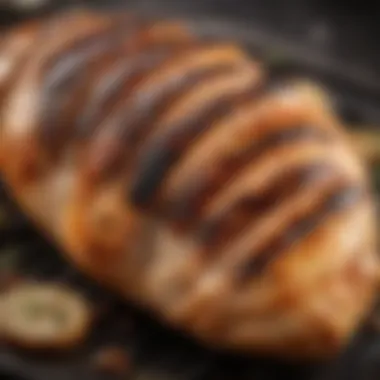Master the Perfect Grilled Chicken Breast Techniques


Intro
Grilling chicken breast is an essential skill for anyone keen on enhancing their culinary prowess. With its lean meat and tender texture, chicken breast often plays a starring role on the grill, appealing to both health-conscious diners and flavor enthusiasts alike. Getting it just right is often a tricky endeavor, leading many to either overcook or under-season, which stands in stark contrast to the juicy and flavorful outcome one strives for.
In this exploration, we'll uncover strategies and secrets that can elevate your grilling game from ordinary to extraordinary. By understanding how to balance flavor and moisture, you'll be primed to impress your guests and perhaps even yourself. The content that follows will meticulously cover the key techniques, marinades, and essential tools necessary for achieving perfectly grilled chicken.
Let's dive into the delicious world of grilled chicken, where you will learn everything from a basic overview, to specific ingredient breakdowns and substitutions for dietary needs, providing a comprehensive approach to mastering this culinary art.
Understanding Chicken Breast
Grilling chicken breast is more than just a cooking method; it's an art that many home cooks aspire to master. Understanding the nuances of chicken breast is pivotal for achieving succulent and flavorful results. This section delves into key elements, benefits, and considerations surrounding chicken breast that every aspiring grill master should grasp. By knowing your ingredients, you set the foundation for outstanding grilled chicken.
Types of Chicken Breast
When it comes to chicken breast, not all cuts are created equal. There are primarily two categories:
- Boneless, Skinless Chicken Breast: This is the most common choice for grilling. It’s lean, easy to handle, and absorbs marinades quickly, making it a popular choice among health-conscious cooks.
- Bone-in, Skin-on Chicken Breast: This cut offers a richer flavor due to the fat in the skin and the moisture retained by the bone. It typically takes longer to cook, lending it some extra depth if grilled right.
Whether you're eyeing the convenience of boneless cuts or the flavor-packed offerings of bone-in pieces, knowing your preference can guide your grilling choices. Each type has its unique flavor profile and texture that directly affects the grilling technique.
Nutritional Profile
Chicken breast is widely regarded for its impressive nutritional benefits, particularly for those looking to maintain a balanced diet. Here's the lowdown on why this protein source earns a spot on many dinner plates:
- High in Protein: Chicken breast is one of the richest sources of protein available, essential for muscle repair and overall health.
- Low in Fat: Compared to other meats, particularly when the skin is removed, chicken breast is relatively low in fat, making it an ideal choice for those monitoring their fat intake.
- Rich in Vitamins and Minerals: Chicken is packed with B vitamins, especially niacin and B6, which play a crucial role in energy metabolism, along with phosphorus and selenium, important for bone health and immune function.
Overall, grilled chicken breast aligns perfectly with a healthy eating plan, providing a nutritious alternative to other red meats.
Choosing Quality Meat
Selecting high-quality chicken breast isn't just about finding the prettiest piece in the aisle. The quality of the meat directly impacts the grilling experience and the final outcome. Here’s what to look for:
- Color and Texture: Choose chicken breast that appears pink, with no grey areas, as it indicates freshness. The texture should be firm and not slimy or overly soft.
- Source: Whenever possible, opt for organic or free-range chicken. These chickens often lead healthier lives, resulting in better flavor and texture.
- Packaging Date: Always check the packaging date to ensure what you’re getting is fresh. Fresh meat yields a distinct tenderness and flavor that’s hard to beat.
By understanding these aspects of chicken breast, you're better equipped to select what will not only taste great but also elevate your grilling game to new heights. Knowing how to appreciate this protein's qualities lays the groundwork for transforming an ordinary meal into a culinary masterpiece.
Essential Grilling Equipment
When it comes to grilling chicken breast, having the right tools at your disposal is crucial. You can think of grilling as a fine art, and like any artist, a cook needs the best materials and instruments to create a masterpiece. The proper equipment not only enhances the cooking experience, but it also affects the outcome of the grilled chicken.
Grills: Gas vs. Charcoal
Both gas and charcoal grills have their staunch supporters, and while one might favor convenience, the other might prioritize flavor. Gas grills are quick to heat up and allow for precise temperature control. They're great for throwing something on the grill at a moment's notice. On the flip side, charcoal grills take a bit more time to heat but offer a unique depth of flavor that many believe gas grills can't match.
- Flavor: Charcoal can give that smoky essence, while gas provides a cleaner taste.
- Convenience: Gas grills offer ease of use, requiring less setup.
- Temperature Control: Gas grills can be adjusted with dials, whereas charcoal requires tending to maintain heat.
Ultimately, the choice is personal. If you've got the time and love that charred flavor, charcoal might be your jam. If not, gas would serve just fine for a speedy cook.
Tools of the Trade
A few essential tools can make your grilling experience seamless. While you might think you only need a spatula and tongs, there’s more to the toolkit than meets the eye. Here's what you might want on hand:
- Grill Tongs: Perfect for flipping and moving your chicken without tearing it apart.
- Spatula: A must-have for ensuring your chicken hasn't stuck to the grill.
- Grill Brush: Maintaining a clean grate not only enhances flavor but also prevents sticking.
- Basting Brush: Ideal for applying marinades or sauces as your chicken cooks.
These tools may seem basic, but they make all the difference in achieving juicy, perfectly grilled chicken.
Thermometers and Their Importance
Let’s be straightforward: there’s nothing worse than pulling a piece of dry chicken off the grill. That's where a meat thermometer comes into play. Understanding the internal temperature of your chicken is paramount to avoid both undercooking and overcooking.
A good meat thermometer helps you check the doneness without cutting into the chicken, which could lose those precious juices. The target temperature for chicken breast is 165°F (75°C). Investing in a reliable thermometer can prevent the disappointment of a poorly grilled meal.
"It’s a wise chef who knows that monitoring internal temperature is just as crucial as the grilling process itself."
With the right equipment, you’re setting yourself up for success. Proper grilling is a combination of technique, understanding, and especially having the right tools. When you create the right conditions, everything else falls into place, shaping an enjoyable grilling experience!
Preparation Techniques
Preparation techniques form the backbone of successful grilling, especially when it comes to chicken breast. It sets the stage for flavor and texture, ensuring that the final product is a juicy, succulent delight. Without proper preparation, you could end up with bland, dry meat that leaves much to be desired. When employing the right techniques, you're not just cooking; you're transforming the meal into a culinary experience. Brining, marinating, and seasoning are all essential methods that every grilling enthusiast should master. They each bring unique benefits and considerations that contribute significantly to the overall outcome.


Brining for Flavor and Moisture
Brining is one of the oldest tricks in the book, yet its effectiveness is often underrated. This technique involves soaking the chicken in a solution of water, salt, and sometimes sugar and spices before grilling. The primary purpose of brining is to infuse the meat with moisture and flavor, making it juicy and tender once it’s cooked.
Here are a few key points to consider about brining:
- Time is of the Essence: Depending on the thickness of the chicken breast and the brine solution, the time for brining can vary. Generally, a few hours will suffice, but for deeper flavor, it can go overnight.
- The Magic of Salt: Salt in the brine helps to break down some of the muscle proteins, allowing the chicken to hold onto more moisture during grilling. This means less risk of dryness.
- Don’t Overdo It: While salt is an ally, too much brining can turn your chicken into a salty mess. Follow recommended ratios and times to avoid this pitfall.
"Brining isn’t just about adding flavor. It’s about ensuring that each bite maintains the juices, taking your chicken from ordinary to out-of-this-world."
Marinades: Flavor Infusion
Marinades are another essential preparation technique that can elevate your chicken breast from ho-hum to heavenly. A good marinade typically consists of an acid (like vinegar or citrus juice), oil, and a blend of spices and herbs. This combination not only enhances the flavor but also tenderizes the meat.
Consider these points about using marinades:
- Time and Temperature: Marinades work best when given sufficient time. A couple of hours can impart some flavor, but overnight is ideal for more robust infusion.
- Offer Balance: Think about balance while choosing ingredients. The acidity should complement the oil and spices without overwhelming the natural taste of the chicken.
- Experimentation is Key: Don’t stick to just one recipe. Try international influences like a Thai-style marinade with lemongrass or a Mexican-inspired mix with lime juice and chili powder. With marinades, variety is the spice of life.
Seasoning Fundamentals
Seasoning is perhaps the simplest yet most vital element of preparing chicken breast for grilling. Basic seasoning can transform an average dish into something memorable. Salt and pepper are traditional staples, but think outside the box.
Here’s what to keep in mind:
- Start with the Basics: Salt enhances flavor, while freshly cracked pepper adds a subtle kick. But don’t stop there!
- Interactive seasonings: Experiment with flavored salts or seasonings such as garlic powder, onion powder, or even a touch of paprika to bring out new dimensions.
- Don’t Forget Fresh Herbs: Fresh herbs can add vibrant flavors that dried ones can struggle to replicate. Chopped basil, rosemary, or thyme sprinkled just before grilling gives a freshness that’s hard to beat.
By mastering these preparation techniques—brining, marinating, and seasoning—you increase the likelihood of serving grilled chicken that is not only appetizing but leaves the guests coming back for seconds.
Techniques for Grilling Chicken Breast
Grilling chicken breast is like walking a tightrope; it requires the right balance of technique and finesse. The methods you choose will not only affect the flavor but also dictate if your chicken turns out juicy or dry. Mastering these techniques can elevate your grilling prowess significantly, resulting in succulent meals that can impress even the most discerning palates. Understanding these techniques is vital for every cook, whether you are flipping chicken on your backyard grill or trying your luck on a professional setup.
Direct vs. Indirect Grilling
When it comes to grilling, knowing when to apply direct and indirect heat makes all the difference. Direct grilling involves cooking the chicken directly over the flame, which allows for quick cooking and nice grill marks. This method is perfect for those quick-cooking pieces, like smaller chicken cuts or skewers. You can really seal in those flavors when the surface gets that nice char. However, you need to keep an eye on it; too much time and you could end up with dry meat.
On the flip side, indirect grilling is your best friend for larger chicken pieces, especially a whole breast. With this method, the chicken sits in a cooler part of the grill. It cooks slowly and evenly, allowing the inside to get tender while the outside remains juicy. For those who like to experiment, mixing both methods can also yield fantastic results. You might start with direct heat to get a good sear and then transfer it to indirect heat to finish cooking.
Controlling the Heat
Cooling your jets is crucial. Knowing how to manage the temperature of your grill can make or break your chicken. You want a hot enough grill for searing, but not so hot that it incinerates your meal. It's about finding that sweet spot—generally between 350°F to 450°F (180°C to 230°C) for chicken breasts. You can test the heat by holding your hand above the grill. If you can hold it there for roughly three seconds, you’re in the right range.
Also, keep in mind areas of your grill can vary in temperature. This is where placement comes into play. Use the hotter spots for searing and the cooler spots for cooking through. A hot grill creates a beautiful crust, while slower cooking allows for moisture retention inside.
Flipping and Moving the Chicken
Much like a seasoned dancer, your chicken's success lies in how you lead and move it. Flipping too soon can lead to sticking or tearing the meat; patience is key. Ideally, you should let the chicken sit undisturbed for about 4 to 6 minutes on one side before flipping. You'll know it's ready to turn when it naturally releases from the grate.
Once you do flip it, do it gently. Avoid shuffling the chicken too much; this can lead to loss of juices. Instead, consider using a spatula or tongs—anything that will keep that delicate flesh intact. Remember, moving it around too often can keep it from reaching that perfect grill sear that everyone loves.
"Mastering the art of grilling is not just about heat; it’s about timing and gentle movement."
In summary, these techniques for grilling chicken breast hinge upon understanding your grill and your meat. Whether you choose direct or indirect methods, control the heat carefully, and flip with finesse, your efforts will be rewarded with mouthwatering results that you can savor.
Cooking Times and Temperature Guidelines
When it comes to grilling chicken breast, understanding cooking times and temperature guidelines is critical. Not only does it ensure food safety, but it also significantly influences the tenderness and juicy texture of the meat. Overcooking can lead to dry, rubbery chicken that feels more like punishment than a culinary delight, while undercooking can risk foodborne illnesses. Finding that sweet spot of perfectly cooked chicken, where it’s safe to eat but still brimming with flavor and moisture, is essential for every home cook.
Determining the Right Internal Temperature
The internal temperature is the heart of the matter in grilling chicken breasts. The target is a minimum of 165°F (75°C), which guarantees that any harmful bacteria are killed. You can’t go wrong with a meat thermometer for this task. Simply insert the thermometer into the thickest part of the breast, avoiding the bone if there is one, to get an accurate reading.
Many people make the mistake of slicing into their chicken to check for doneness. Not only is this a hit-or-miss method, but it also lets the valuable juices escape—resulting in even drier meat. Instead, let the thermometer do the talking. Once you’ve reached that magic number, you can let the chicken rest for a few minutes, which allows the juices to redistribute, enhancing both flavor and moisture.
"Resting the chicken is like a breather between performances; it recharges the flavors back to life."
Timing Based on Thickness
Thickness affects how long chicken breasts take to grill properly. A chicken breast that’s 1 inch thick will typically cook faster than one that’s 2 inches thick. Here’s a handy guideline to keep in mind:


- Thin Chicken Breasts (about 1 inch): 6-8 minutes per side
- Medium Chicken Breasts (1.5 inches): 8-10 minutes per side
- Thick Chicken Breasts (2 inches or more): 10-12 minutes per side
It's advisable to flip the chicken only once to ensure even cooking and nice grill marks. The best practice here is to monitor closely and use your experience to adjust timing as necessary. Don’t let time dictate your grilling; instead, let the chicken itself guide you.
To sum it all up, keeping an eye on internal temperature while timing based on thickness can elevate your grilled chicken from mediocre to mouth-watering. Mastering these guidelines will provide a reliable foundation for achieving delicious results, every time you hit the grill.
Post-Grilling Steps
Once you've perfected the grilling of chicken breast, there are a few steps that should not be underestimated. While grilling itself is a crucial part of the preparation, how you handle the chicken once it comes off the grill can elevate your dish from good to exceptional. This part of the process emphasizes patience and precision, allowing the flavors to settle and ensuring a pleasing texture.
Resting the Chicken
Resting chicken breast is akin to giving it a well-earned break after a hard day on the grill. When you grill chicken, the fibers within the meat contract and the juices are pushed towards the center. If you cut into it immediately after grilling, all that flavorful juice will spill out onto your plate instead of staying locked in the meat.
Allow your chicken to rest for about five to ten minutes, depending on the size of the breast. This waiting period permits the juices to redistribute throughout the meat, leading to a much juicier final product. Think of it as a calming spa retreat for your chicken before it meets the plate.
Slicing Techniques
How you slice the chicken can make all the difference in presentation and overall experience. A common pitfall is cutting against the grain, which can result in tough chunks of meat. Instead, recognize how the fibers are positioned and slice perpendicular to them. This technique keeps the meat tender and delightful to chew.
- Let the chicken cool slightly before slicing—it helps maintain moisture.
- Use a sharp knife; a dull blade can tear the fibers instead of cleanly severing them.
- Cut at an angle for larger chicken breasts to showcase the juicy inside, and remember to keep the slices uniform to ensure even presentation.
A well-sliced chicken breast not only looks inviting but also allows for a better chewing experience, keeping diners coming back for more.
Serving Suggestions
When it comes to serving grilled chicken breast, consider it the canvas for your culinary artwork. You might stick to the classic approach or get a bit creative. Pair your beautifully grilled chicken with a variety of sides and garnishes that complement its flavor.
- Fresh Salads: A bright arugula salad with lemon vinaigrette can balance the savory taste of the chicken.
- Grains: Consider serving it alongside a bed of couscous or quinoa, enhancing both texture and nutrition.
- Sauces: A drizzle of chimichurri or a dollop of tzatziki can add a pop of flavor that transports your grilled chicken to new culinary heights.
Don’t forget to plate with care. A sprinkle of fresh herbs or a slice of lemon can take your dish from ordinary to extraordinary. Take the time to arrange it aesthetically, encouraging your diners to enjoy not just the flavors but the look of the meal. Good presentation is part of the overall dining experience.
"The first bite is with the eyes."
Common Mistakes to Avoid
When it comes to grilling chicken breast, a few blunders can turn a juicy piece of meat into a dry, disappointing plate. Knowing these common mistakes is essential. They not only affect flavor but also impact the overall experience of grilling. By sidestepping these pitfalls, you can elevate your cooking skills and impress any gathering.
Overcooking Issues
One of the most significant missteps in grilling chicken breast is overcooking. The delicate nature of chicken breast means that it can become rubbery and dry if cooked too long. The ideal internal temperature for grilled chicken breast should hover around 165°F (75°C). However, a common mistake is not using a meat thermometer to check for doneness. Many rely on time alone, which can vary based on grill heat and chicken size.
- Tip: Invest in an instant-read thermometer to ensure your chicken is perfectly cooked. Insert it into the thickest part of the breast to check the temp.
- Remember, take the chicken off the grill about five degrees early; it will continue to cook while resting.
Neglecting Marinades
Marinating chicken breast is not just about adding flavor; it also helps in tenderizing the meat. Many home cooks make the mistake of neglecting this step entirely. A good marinade can work wonders. It not only infuses flavor but also keeps the chicken moist during grilling.
- We can think of marinades as a bath for our chicken. They can be oil-based, yogurt-based, or even citrus-based.
- If you're tight on time, even a quick 30-minute soak can significantly improve the taste and texture of your meat.
Some Popular Marinades Include:
- Lemon Herb: Fresh lemon juice, olive oil, garlic, and herbs like thyme or rosemary.
- Teriyaki: Soy sauce, ginger, garlic, and sesame oil create a sweet and savory profile.
- Spicy Buffalo: Hot sauce, butter, and a touch of vinegar for those who like it fiery.
Insufficient Cleaning of Grates
Another mistake that often goes unnoticed is the failure to clean the grill grates properly. Grime and residue from previous cooks can lead to sticking and uneven cooking, ruining your chicken breast's beautiful sear. A dirty grill can affect flavor, leaving an unpleasant taste on the chicken, which no amount of marinating can fix.
- Before every grilling session, ensure your grates are clean. Use a grill brush while the grill is still hot to scrape off remains.
- A clean grill helps with heat distribution too, giving your chicken an even cook.
"Cleanliness is next to juiciness!" This old adage rings true when grilling chicken breast.
By being mindful of these common mistakes—overcooking, neglecting marinades, and insufficient cleaning of grates—you can significantly improve your grilling game. Mastering these aspects ensures that your chicken breast remains tender, flavorful, and a standout feature at dinner.
Enhancing Flavor Profiles
In the quest for grilling chicken breast that tantalizes the taste buds, understanding how to enhance flavor profiles is paramount. This section delves into specific elements like herbs and spices, the influence of wood chips, and the art of glazes and sauces. Mastering these components not only elevates the dish but also allows home cooks to express their creativity and cater to diverse palates.
Herbs and Spices Combinations


Using herbs and spices can transform ordinary chicken breast into something extraordinary. When combining various herbs and spices, consider their complementary nature. For instance, rosemary's earthy notes might blend beautifully with lemon zest's brightness. A popular combination is garlic powder, onion powder, and paprika, creating a harmonious blend that ensure that the depth of flavor shines through.
Utilizing fresh herbs is another way to enhance the flavor. Chopped parsley, cilantro, or basil can add a bright finish just before serving. Another tip is to incorporate spices that offer heat, such as cayenne or chili powder, if you want to kick things up a notch. Here are some useful combinations:
- Herbs de Provence: A mix of thyme, basil, and lavender. Ideal for chicken to provide an aromatic experience.
- Italian Blend: Oregano, garlic, and red pepper flakes create depth and warmth in flavor.
- Cajun Spice: A zesty concoction of paprika, cayenne, and thyme that adds a southern punch.
Influence of Wood Chips
The choice of wood chips for grilling adds another layer of flavor that can be quite surprising. Different woods impart unique tastes. For instance, hickory can give a robust flavor, while applewood offers a sweeter, more subtle aroma. Soaking the chips in water for about 30 minutes before use can help prolong their burning time, creating a smokier profile.
Pros of different wood types include:
- Hickory: Rich and emboldened flavor, excellent for longer grilling times.
- Mesquite: Strong and assertive, good for short grilling sessions.
- Applewood: Sweet and fruity, pairs well with poultry for a mild flavor.
When experimenting, it’s wise to avoid overloading the chicken, as too much smoke can produce bitterness. The goal is to create an inviting and complex flavor that doesn't overshadow the natural taste of the chicken.
Utilizing Glazes and Sauces
Glazes and sauces serve as the cherry on top when it comes to finishing grilled chicken breast. They offer moisture and an additional flavor punch. A simple honey mustard glaze, for instance, balances sweetness with tanginess, beautifully complementing grilled chicken. Similarly, a balsamic reduction can add a touch of acidity and sweetness that makes each bite utterly delightful.
Consider these types of glazes and sauces:
- Barbecue Sauce: A classic choice that gives a smoky and tangy finish. It can be brushed on the chicken during the last few minutes of grilling to prevent burning.
- Teriyaki Sauce: Infuses an Asian flair with sweetness, perfect for a different twist on chicken.
- Chimichurri: This fresh herb sauce brings vibrancy and brightness, perfect for grilled meats.
A well-balanced glaze not only adds flavor but also keeps the chicken moist, ensuring each bite is a delightful experience.
Variations on Grilled Chicken
When it comes to grilling chicken, mixing it up can truly elevate your culinary game. Variations on grilled chicken allow not only for creativity but also introduce new flavors that can surprise your taste buds. These variations are more than just fun; they can cater to different dietary preferences, cultural influences, and even seasonal availability of ingredients. Emphasizing variations also brings an opportunity to showcase diverse cooking techniques and facilitate a deeper appreciation for the global scope of food.
Stuffed Chicken Breast Techniques
Stuffed chicken breasts present a delightful twist on the conventional grilled experience. This technique involves creating a pocket in the chicken breast and filling it with various ingredients, resulting in a dish that is both flavorful and visually appealing. The key is to ensure that the stuffing complements the chicken without overwhelming its natural taste. Here are a few steps and tips to get started:
- Selecting the Right Filling: Consider using cheese, vegetables, or even fruits. Ingredients like spinach and feta or mushrooms and provolone make for classic combinations. You could also explore non-traditional stuffings like dried cranberries with walnuts, which provide a unique flavor profile.
- Creating the Pocket: Use a sharp knife to carefully slice into the thickest part of the chicken breast, creating a pocket that is deep enough to hold the filling but not so deep that the chicken falls apart.
- Binding the Stuffing: To ensure the stuffing stays put, use toothpicks or kitchen twine to close the opening after filling. Remember to place the stuffed chicken on a grill-safe dish as it can leak during cooking.
- Cooking Considerations: Stuffed chicken breasts may take longer to cook than standard ones, but be careful not to overdo it; aim for that magic internal temperature to keep it juicy.
"Stuffed chicken breasts transform an ordinary meal into a feast, opening doors to creativity and delight."
By experimenting with various ingredients, you can create a medley of tastes that cater to any occasion.
International Marinade Inspirations
Marinades are a fantastic way to infuse chicken with robust flavors, and drawing inspiration from global cuisines can elevate grilled chicken to new heights. Each culture offers unique combinations that can bring out the best in your chicken. Here are a few international marinade inspirations to consider:
- Mediterranean Influence: A mixture of olive oil, lemon juice, garlic, oregano, and thyme creates a zesty Mediterranean marinade. This not only enhances flavor but adds freshness to the grilled chicken.
- Asian Fusion: Soy sauce, ginger, garlic, and sesame oil work wonders in an Asian-inspired marinade. This offers a savory umami taste combined with a hint of sweetness.
- South American Spice: Adobo sauce made with chilies, garlic, and vinegar can spice up your chicken in a unique way. It’s vibrant and adds depth that will excite any palate.
- Indian Flavors: A yogurt-based marinade with spices like cumin, coriander, and turmeric can make the chicken tender while imparting aromatic flavors.
Mixing and matching these global tastes fosters exciting outcomes each time you grill. They not only diversify your meal options but also bring cultural richness to your dining experience. Consider adapting these ideas to suit local tastes or whatever ingredients might be on hand, creating a truly personalized grilled chicken experience.
Grilling as a Social Activity
Grilling isn’t just about cooking. It’s a cultural phenomenon that often brings people together, fostering bonds while tantalizing their taste buds. The experience of grilling chicken breast becomes a shared celebration, and rightfully so. Whether it’s a summer barbecue or a cozy evening gathering, the act of grilling transforms a regular meal into a memorable event.
Creating a Grilling Environment
Setting the scene is vital in achieving that inviting atmosphere. Here are some considerations that can help make your grilling experience more enjoyable for all:
- Ambiance: Consider string lights and outdoor candles to create a cheerful vibe, especially as dusk approaches.
- Comfortable Seating: Make sure there are enough chairs and tables for everyone. Outdoor cushions can add a touch of comfort.
- Music: A carefully curated playlist can enhance the mood. Choose tunes that fit the occasion, whether it's a laid-back afternoon or a lively evening.
- Safety Measures: It’s important your guests feel safe. Keep a fire extinguisher nearby, and educate anyone around how to handle potential grilling hazards.
Creating this environment not only prepares the stage for grilling but invites conversation. Guests naturally gravitate toward the sounds, sights, and smells of grilling, prompting them to engage with you and each other.
Pairing with Side Dishes
A well-grilled chicken breast shines brightest when complemented with equally delightful sides. Consider these pairing ideas to elevate your meal:
Classic Options:
- Coleslaw: Its crunchy texture and tangy flavor are a refreshing contrast to grilled chicken.
- Corn on the Cob: Grilled corn, brushed with butter and sprinkled with salt, adds sweetness and juiciness.
- Potato Salad: A creamy potato salad can be a hearty side that blends well with the flavors of the chicken.
International Flair:
- Tabbouleh: This Middle Eastern salad, brimming with parsley, tomatoes, and bulgur, presents a fresh twist.
- Grilled Vegetables: A medley of colorful bell peppers, zucchini, and asparagus can add an artistic touch to the plate.
- Rice Pilaf: Seasoned rice dishes can beautifully harmonize with grilled chicken, especially if flavored with herbs.
Pairing your grilled chicken with complementary side dishes not only enhances the overall flavor profile but also encourages your guests to explore different tasting notes.
"Good food is the foundation of genuine happiness."
When grilling becomes an active social event, the culinary experience transcends the kitchen. It embodies laughter, conversation, and connection, adding layers of richness to the simple act of cooking. Enjoying grilled chicken with good company and delightful sides can lead to unforgettable gathering moments. Always remember, it’s these little elements that elevate a meal into a cherished memory.















